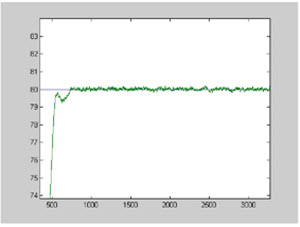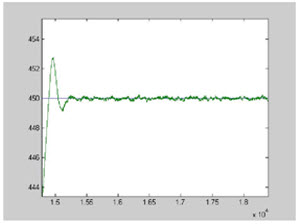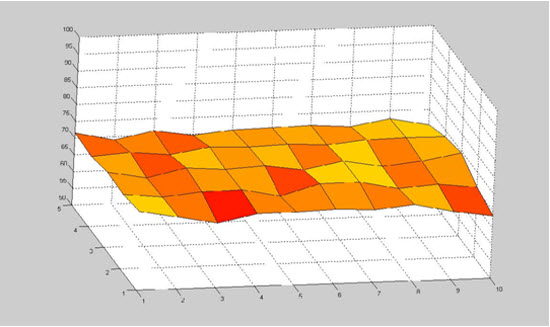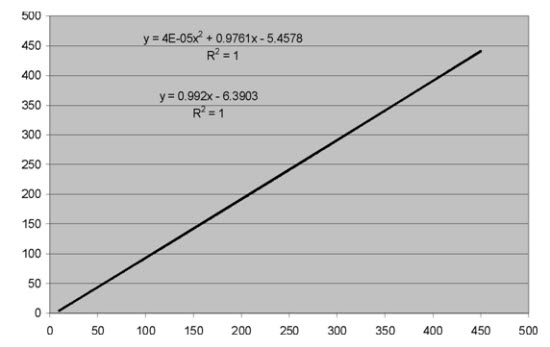Temperature Accuracy and Precision of the BD50s Block Digestion System 
The following data shows the accuracy and precision of the BD50 Block Digestion System across its operating temperature range (ambient to 4500C). The temperature specification for the BD50 is to maintain a consistent temperature across the block (within +/-20 C). Note the performance of the block has been optimized for the situation when it is fully loaded with a full set of digestion tubes and samples.
It will perform slightly differently when not loaded with any digestion tubes due to the difference in thermal mass.
1. Temperature Precision at Different Temperatures

The above graphs shows heating a fully Loaded block to 800C. The block very quickly heats to 79.50C and then takes a few minutes to reach final temperature. Once the block reaches the setpoint temperature, it maintains it within +/- 0.20 C.

Heating an unloaded block to 4500C shows a similar performance though in this case there is an overshoot in the setpoint temperature of the block caused by reduced thermal mass of not having digestion tubes in place. As above, once the block reaches the setpoint temperature,it maintains the setpoint temperature within +/- 0.20 C.
2. Precision of Temperature Ramping
Positive Ramp at 5 degrees per minute.
Positive Ramp at 1 degrees per minute.
The results from testing show that the control system controls the block temperature to within +/- 0.20 C This is a full order of magnitude better than the specified +/- 20 C.
Rise time is as fast as allowed by the thermal mass of the BD50 block, and is much faster than the older BD50 Block Digestion System, which used a gain scheduling approach to reduce power as the block reaches a setpoint. There was no significant phase delay measured in the ramp rates.
3. Accuracy of Block Temperature
3.1 Calibration Accuracy
Using the thermocouple simulator the block was calibrated for 2 points (user calibration) and 5 points (factory calibration).
The calibration values were:
| Number of Points |
Gain |
Offset |
| 2 |
0.6788 |
0.6766 |
| 5 |
121.56 |
120.715 |
After calibration, the full range of temperature from 0 to 4000 C was reported correctly to +/- 10 C, regardless of the number of calibration points. The readings did not drift over a test period of 24 hours.
3.2 Absolute Accuracy
In section 1, it has been shown that the control accuracy is to within 0.20 C. However this assumes the thermocouple is measuring the actual block temperature. To check the thermocouple reading against the actual block temperature, several vial reservoirs were coated in heat-sink compound, and a welded tip thermocouple was inserted into the heatsink. The block was heated to certain temperatures according to the thermocouple and soaked for 20 minutes. The actual block temperature was measured as an average across 5 tubes spread across the block surface. Controller Temperature Reading Average Block Temperature.
| Controller Temperature Reading |
Average Block Temperature |
| 22.0 degrees |
22.7 degrees |
| 80.0 degrees |
79.2 degrees |
| 200.0 degrees |
200.6 degrees |
These readings show the measured temperature matches the actual block temperature to within 10 C.
It should be noted that these measurements are an average of 5 vial positions. All positions were within 20C of each other. Also the measurements were made near the bottom of the vials (1/3rd from the bottom), the temperatures at the top of the vials are typically 1- 20C cooler. Therefore the specified +/- 20C has been achieved, but will depend greatly on where and how the block is measured.
4. Sample Temperature
A BD50 Block Digestion System was fully loaded with 50 digestion tubes of water. The tubes were surrounded with a draft shield and the block was heated to 800 C. When the block reached 800 C, the water samples had only reached a temperature of 410 C, indicating the delay in heat transfer from block to sample.
A BD50 Block Digestion System was fully loaded with 50 digestion tubes of water. The tubes were surrounded with a draft shield and the block was heated to 800 C. When the block reached 800 C, the water samples had only reached a temperature of 410 C, indicating the delay in heat transfer from block to sample.
The hottest measurement was 74.60 C and the lowest was 68.50 C with a std dev of 1.250 C. The distribution of temperature is shown on the surface plot below.

This plot shows the temperature of each sample versus its position in the block and shows there are no localised hot or cold spots.
5. Temperature Linearity
The design of the BD50s includes a thermocouple transmitter that performs some electrical linearization on the thermocouple signal. The firmware can then scale and shift this linear signal into an accurate temperature reading.

The graph shows the actual block temperature versus temperature reported by the controller.
The results show the output of the transmitter is very linear across the operating range of the block and requires zero/gain compensation (linear).
6. Summary
The BD50s controller is capable of controlling the temperature of the BD50s block to within 0.20C.
The variation in temperature across the BD50s block at a specific temperature is within +/- 10C.
The BD50s block is linear in temperature across the range of ambient to 4500C.